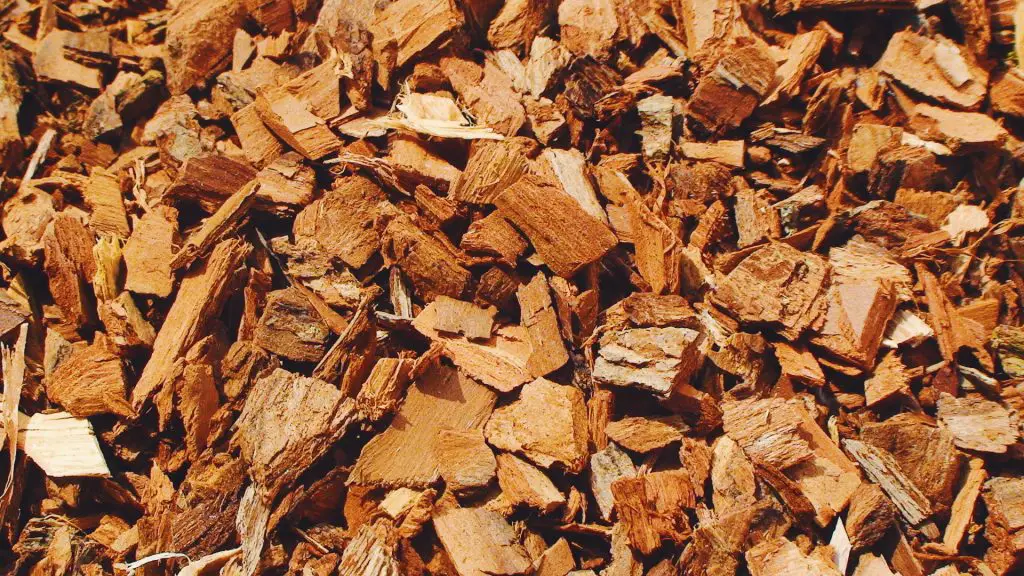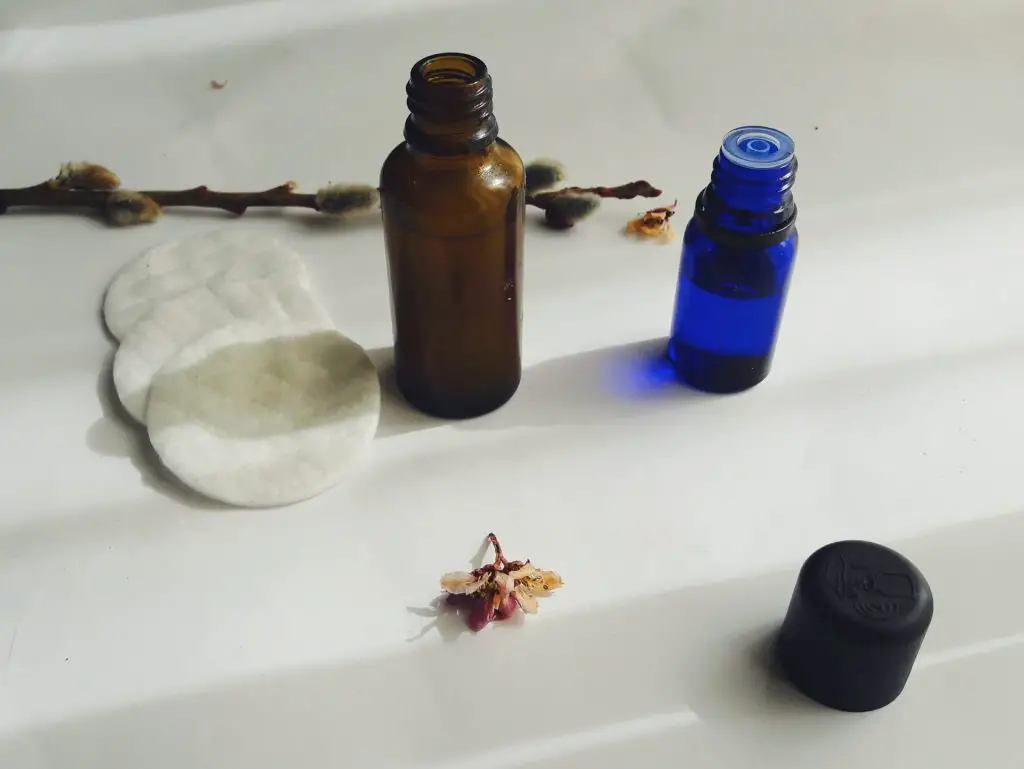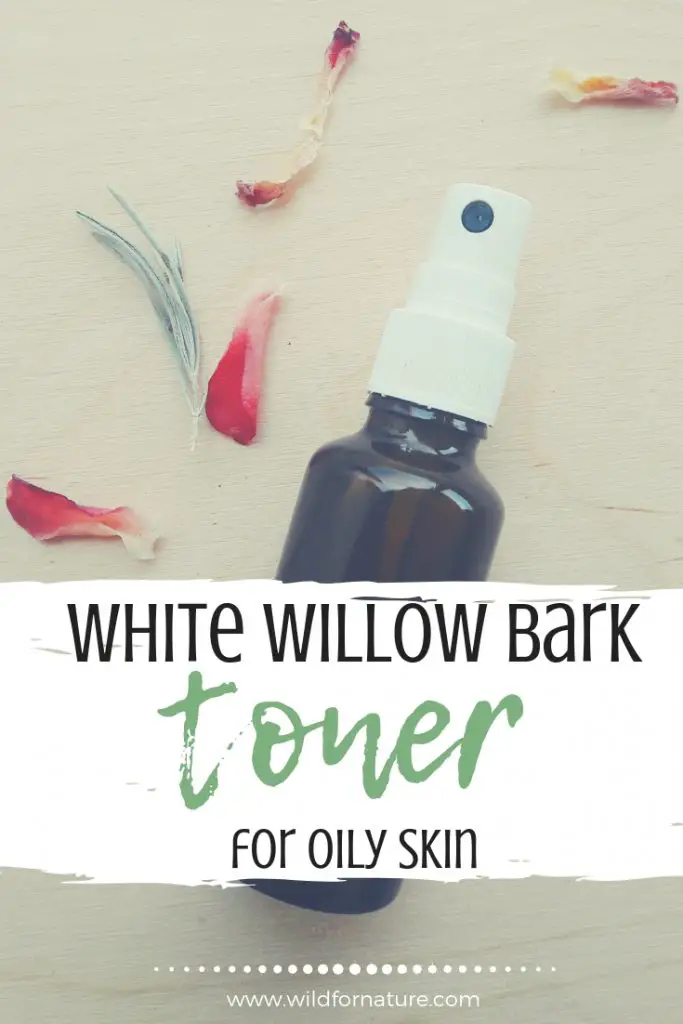Acne is an annoying and constant problem with many of us and if you’re like me, you probably want to avoid the commercial products (because they either don’t work or make the situation worse). That’s why I decided to make another anti-acne post.
Today we’re making white willow bark anti-acne toner. There are plenty of white willow bark skin benefits; hopefully, this toner can help make a difference.
White willow benefits for skin

Last week my post on bentonite clay anti-acne face mask appeared in The Sun (yay!) and Glamour (how glamorous is that!). That’s why I decided to make another anti-acne post because these just seem to be the most popular.
Last month I wrote about white willow bark health and skin benefits, anti-acne being one of them. Read it here, but I’ll recap where the white willow bark benefits for skin come from:
Willow bark contains salicin, an active compound in the bark that has antiseptic, antipyretic, analgesic, and disinfectant properties. Apart from that, white willow bark is also anti-inflammatory, anti-microbial, and anti-fungal.
Since most of us are looking for a natural way to get the acne under control, salicin just might be the answer. It is one of those natural and organic ingredients that can help, a natural aid in the endless acne fight.
Salicin and salicylic acid- that’s the same thing, right?
Let me clear the confusion I was once in myself. The claim that salicin and salicylic acid is one and the same thing is false. Salicin is not the same as salicylic acid.
Salicin is converted into the salicylic acid when taken orally because our enzymes take care of that. When salicin is applied topically, it cannot be converted into salicylic acid; there are no enzymes on the skin that would do that.
White willow bark benefits for skin: yes or no?
So, is willow bark good for acne or not? Yes, it is. Willow bark still contains all the powerful properties that aid our skin naturally. It’s not only good for acne, but for anti-aging, oily skin, and other skin conditions (eczema and psoriasis).
White willow bark promotes healthy and toned skin when applied topically. With its antioxidant and anti-inflammatory properties, it is both a natural remedy for oily skin and a natural exfoliator. Either way, it keeps the skin regenerated and smooth.
White willow bark anti-acne toner

The toner will leave your skin refreshed. It’s very easy to use it; apply a bit on a cotton pad and swipe it on your face (after the cleanser). Repeat the process if you wish until the pad is completely clean.
Witch hazel
Witch hazel is good for your face. It’s very beneficial for the skin in general due to its antioxidant and astringent properties. Witch hazel aids with acne, eczema, and boosts the healing process of the skin. Moreover, witch hazel also nourishes dry skin and it’s one of those natural and organic ingredients in toners that is refreshing and can even minimize puffy eyes.
Ylang-ylang essential oil
Even though this essential oil has many skin benefits, it hasn’t been as popular and as well-known as it should until recently. It has a wide number of properties, antimicrobial, astringent, and antidepressant being just a few of them.
Ylang-ylang essential oil soothes irritated skin, it helps to regulate the sebum which makes it great for combination skin. A natural remedy for eczema, this oil also promotes healthy and glowing skin.
White Willow Bark Anti-Acne Toner
Ingredients:
– 1 TBS white willow bark
– 1/3 cup boiling water
– 2 TBSP witch hazel
– 1TSP vegetable glycerin
– 6-10 drops ylang-ylang essential oil
Instructions:
- Add the bark to a tea filter (paper or metal)
- Place it in a cup
- Pour over boiling water
- Let it sit for 10-15 minutes
- Combine the rest of the ingredients in a 30 ml glass bottle (witch hazel, glycerin, and essential oils), shake the bottle well to combine
- Fill the rest of the bottle with willow bark “tea”
Notes:
1. The ylang-ylang essential oil is optional; substitute it for other essential oil that works well for acne prone skin (lavender, sage, tea tree…)
2. You can omit glycerin if you have none at hand
3. Keep the toner in a cool place; if you’re worried it might go bad, store it in the fridge
4. I use a dark glass amber bottle to store the toner
5. Local health stores may sell white willow bark
I’d love to hear from you! What is your experience with white willow bark?
Stay Wild!


Hi, I have read an article about willow bark toner. Tell me how long I can Store it in the fridge?
Hey, this is an older recipe where I had no idea that preservatives exist :). In the fridge, this would last only a few days. I’d recommend you use distilled water when preparing willow bark tea. Also, for actual shelf life and protection of the toner, add a preservative in there (you can read more on preservatives here). Hope this helps!
I have willow bark powder. I don’t want fragments in the toner. A tea bag will prevent that?
Hi Cynthia! Yes, a teabag would help prevent fragments of powder in the toner. Happy crafting 🙂
Is the vegetable glycerin a preservative in this recipe? If I were to use benzoyl alcohol how much would I add? How much does this make in one batch?
Hi Christin,
I don’t recommend making this recipe in this form anymore; the glycerin isn’t a preservative here and since this is made with freshly boiled water, it’s pretty difficult to preserve it at all. If you’re skilled with DIY, I suggest you get a willow bark extract instead (like this one from LotionCrafter) of making your own. Then, you can combine it with other ingredients and preserve it with Cosgard or Liquid Germall Plus (you can read more about preservatives here). But, I haven’t tried making this recipe with bark extract, so you’ll have to test it out on your own. Here’s how I’d start if I wanted to use a 30ml bottle: 1g vegetable glycerin, 1.5g white willow bark extract, 0.2g ylang-ylang EO, 0.35g preservative, and top up the bottle with witch hazel. Hope this helps! Let me know how it worked for you! Happy crafting, Kat
I’m trying to try this recipe. However, I don’t know where to get the willow back. I only have the willow back cut and sifted. the one you used, is it an extract or powder or liquid? How do I use the herbs?
Hey Edna, the one I used in the original recipe was bark herb cut, but I don’t recommend using the method described above. You can use a white willow extract which you can get online (from LotionCrafter or Formulator’s sample shop, Making Cosmetics). Use the extract according to the suggestions of the supplier, mix it with other ingredients, and add a preservative to the recipe so that it doesn’t begin to grow mold or bacteria. Hope this helps!